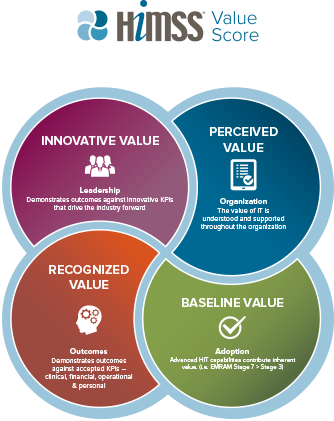The value in Value Score

Guest post from Lorren Pettit, MS MBA, Vice President, Market Research, HIMSS
I have a confession.
For a long time I never questioned the value of health information technology.
I entered the HIT industry a few years ago, attracted by the explosive growth this sector was experiencing. If the market and the federal government were willing to spend billions of dollars on HIT, then there must be something there, right? It came as a surprise to hear anyone questioning the value of an HIT investment. In fact, my first reaction was to dismiss these concerns as the grumblings of nay-sayers who look for things to be unhappy about.
Yet the calls questioning the value of HIT did not go away. In fact, they intensified.
Recognizing the potential challenge these conversations could have for various HIMSS stakeholders (e.g. CIOs), HIMSS leaders sprang into action. First, there was an effort to shape the HIT value nomenclature. This resulted in the HIMSS Health IT Value Suite and the Value STEPSTM framework. Second, we set out to develop a robust, standardized, objective tool by which to numerically express the impact of health IT in a healthcare organization, or as it would later be called, a Value Score.

As one of the principle architects of the Value Score, it was important to me that we did not base our “value” of health IT assessment on a financial return-on-investment (ROI) calculation. While there is a place for ROI assessments, there is a complexity to these calculations applied to the EHR which makes it virtually impossible to develop a tool which would be universally embraced. Our starting point was more simplistic but no less significant.
The Baseline Value
First, we acknowledged that healthcare organizations, like the human body, “metabolize” patient data at different levels based on the capabilities of the organism. Organizations with more advanced capabilities inherently realize more value from their patient data than organizations with less sophisticated health IT infrastructures. As such, an organization’s HIMSS Analytics Electronic Medical Record Adoption Model (EMRAM) score functioned as an ideal proxy for this “baseline value” metric.
The Perceived Value
Another factor driving our value calculation involved the shared understanding leaders have around the impact health IT has on their organization. Referred to as “perceived value,” the organization’s orientation toward health IT provides insight into the areas where leaders “expect” health IT value to be realized.
Realized and Innovative Values
The final value drivers in the model (realized value and innovative value) are grounded on the understanding that value is to be managed. You cannot “slap” information technologies in and automatically expect to realize value. It is important to measure what you want to manage. As such, both the realized and innovative values lean heavily on the documented evidence organizations should be amassing as they attempt to manage their health IT investments.
Being a part of the Value Score development team has had a significant impact on my growth as a manager. I learned that it is not only right, but a duty, to question the value of health IT.
I, for one, am not afraid of what these challenges will yield for health IT.
Lorren Pettit, MS MBA is Vice President, Market Research for HIMSS. Pettit works with an expert team offering clients strategic guidance toward achieving sustainable growth and market leadership positioning.
